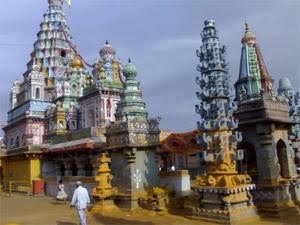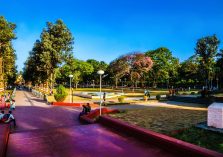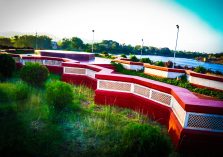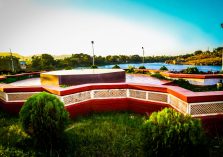Karad Taluka
Koyna was known as Karha in ancient times. Karhatak, situated on the banks of Karha, evolved into Karhat, Karhad, and Karad. There was a temple of Mahalaxmi of Kolhapur here, which was destroyed during the Muslim rule. Currently, there is a platform, and the locals bury the dead there. Saint poet Vitthoba Anna Daptardar was from here. This city on the Krishna-Koyna confluence is the workplace of Maharashtra’s first Chief Minister and former Deputy Prime Minister of India, Late Yashwantrao Chavan, and their memorial lies at the Krishna-Koyna confluence. Nearby, in Jakkinwadi, in cave no. 6 among the 54 Buddhist caves, the Dhammachakra, which had not been discovered before, was found.
Pal
On the banks of the Tarli River, Pal is home to the revered Khandoba temple. It is about 7 km west of Kashil on the Pune-Bangalore highway. The village on the banks of the Tarla river is famous for the Khandoba temple. It is a Hemadpanti temple with fortifications on all four sides. The temple has carvings of snakes, rivers, etc., and has the idol of Khandoba’s second wife, Balubai.

Pal
Krishna Ghat
To the north of this city is the holy confluence of Krishna and Koyna. There is a memorial of Yashwantrao Chavan. A beautiful garden has been created near this memorial. The garden is filled with greenery, flower plants, ornamental plants, and many shady trees, making it a scenic spot. The garden has slides, swings, and many other modern playthings for children. Entry to this garden is free for everyone. This memorial attracts tourists and political leaders alike. The oldest temple of Ratneshwar is situated on this ghat. This temple has 4 minarets in Islamic style and a pinnacle in Hindu style. The Krishna Mai Devi fair is held on the 1st day of the dark half of Chaitra month and the last Monday of Shravan month.

Krishna Ghat
Manore
An interesting site in Karad is Minarets. It is an old stone mosque. Karad has a significant Muslim population. Many people come to this mosque daily for prayers. The mosque is built of stone, with intricate carvings on the outer sides near the ceiling. Inside the mosque, there are Urdu inscriptions on stone slabs. Behind the mosque, there is a wooden gate with two 106 feet high round minarets on either side. Inside these minarets are circular stone steps leading to the top. From the top of these minarets, one can see the far-reaching surroundings of Karad. Ibrahim Khan constructed it during the reign of Sultan Ali Adil Shah I of Bijapur in 1557.
Sadashivgad
Among the 27 historical and majestic forts in Satara district, Sadashivgad is one of the forts from Shivaji’s era. It is located about 7 km east of Karad city. This fort is also known as Shivgad because of the Shivshambhu Mahadev temple on it. This fort, built by Shivaji Maharaj, spans 23 acres. During Shivaji’s era, this fort was used for enemy reconnaissance. The Shivshambhu Mahadev temple on this fort is worth seeing. It is as ancient as the fort itself. There are metal idols of Lord Shiva and Ganesh near the shrine. This temple sees a large crowd every Monday in Shravan month, with a fair held on the last Monday. At the base of Fort Sadashivgad are four villages: Rajmachi, Vanvasmachi, Hazarmachi, and Babarmachi. The fort also has a self-manifested Shiva temple.
Sagreshwar
On the Karad Tasgaon road, at the base of Yashwant Ghat, there is a complex of about 22 temples. This sanctuary spans 1088 hectares near Devarashtre and Kirloskarvadi. It houses the temples of Sagreshwar, Kuber, Kapileshwar, Trimbakeshwar, Nageshwar, Rameshwar, etc. The Samadhi of Sage Karkotak is also here. This sanctuary is famous for blackbucks, deer, peacocks, rabbits, wolves, and primarily for deer.
Agashivnagar
The area of Agashiv was once known as Golibar and is now known as the Malkapur/Krishna Hospital area. The ancient Shiva temple on this hill is notable. Near this Shiva temple, there are 22 rock-cut caves. Outside cave no. 6, on the right side, there is a Dhammachakra, and on the left side, a carved lion.
Vasant Gad
Vasant Gad lies near the village of Talbid, close to Karad. After killing Afzal Khan in 1659, Shivaji Maharaj took control of this fort. Later, on August 25, 1699, Aurangzeb captured the fort and renamed it Vijay Killa. Subsequently, Tarabai imprisoned Ramchandra Pant Amatya here. An annual fair is held on this fort, and there is a large ancient tower to the north of the temple.
Bhui Kot Fort
Near the confluence of Krishna, there is a Bhui Kot Fort within Pant’s Kot, but it is in a state of disrepair.
Talbid
The memorial of Sarsenapati Hambirrao Mohite is located here.
Contact Details
Address: Karad Taluka

How to Reach
By Train
The Karad Railway Station (KRD) is on the Pune-Miraj line. Trains from Mumbai and Pune stop at Karad.
By Road
Travel from Satara to Karad by vehicle, or take a bus.








